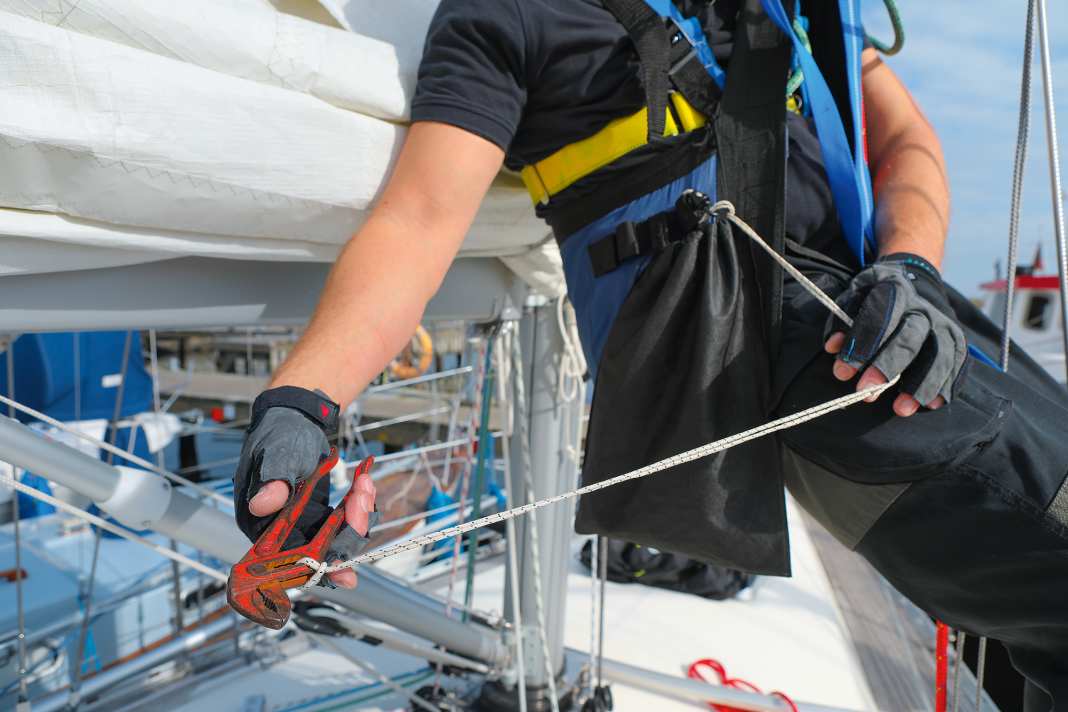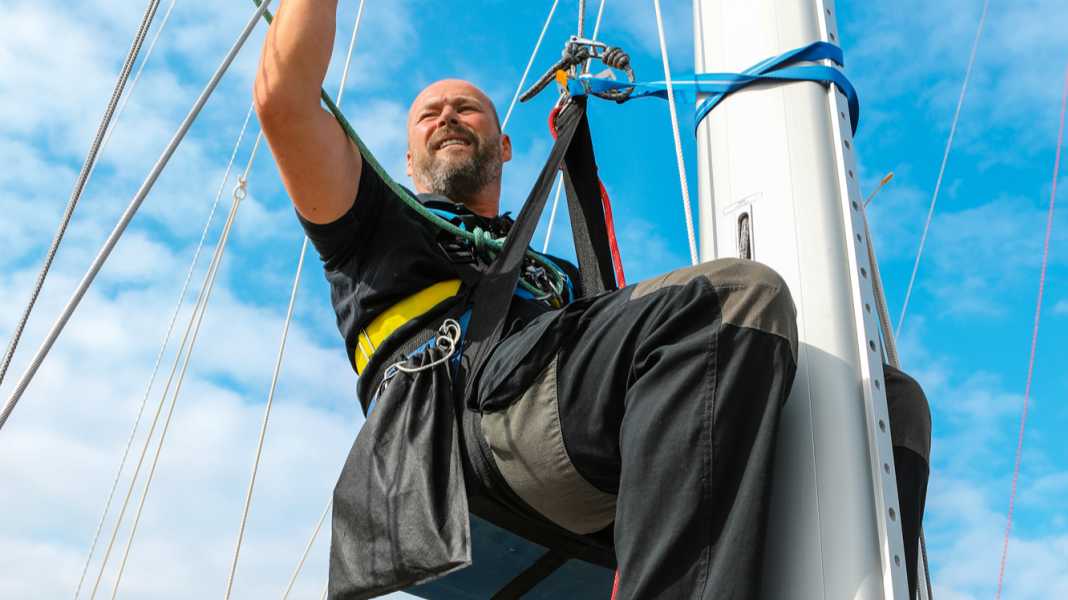
Reaching the mast is usually a physical and mental feat of strength. Physical fitness and anxiety play a major role in this. Therefore, if you are unsure, it is better to refrain from climbing unless it is an emergency.
With the right equipment, preparation and realisation, the stresses and dangers can be reduced to a minimum. Owners or charter skippers can fix minor annoyances such as a defective bulb in the top light, a twisted Windex or torn lazy-jack lines themselves.
This article shows how to stay in the mast using the utensils and fittings normally on board.
Boatswain's chair vs. climbing harness
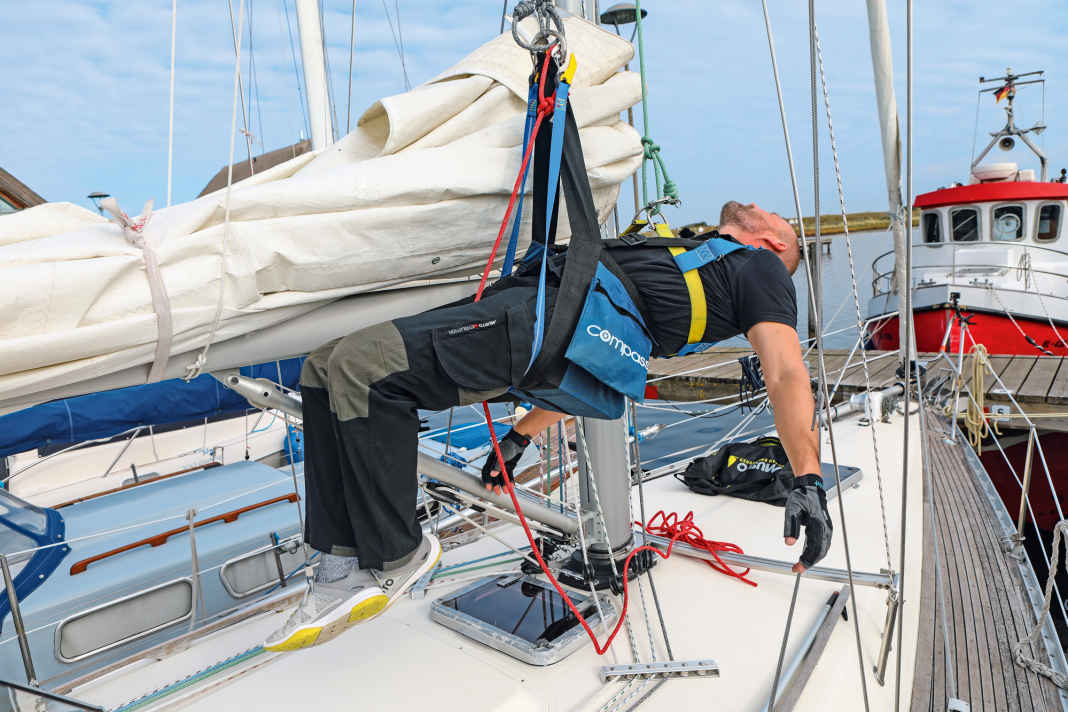


The equipment that should be on board includes a suitable bosun's chair or climbing harness. Both systems have advantages and disadvantages. Boatswain's chairs with an integrated seat board offer a lot of comfort, but restrict freedom of movement, especially when climbing along. With a shoulder harness, they can also be powerless-proof. Important: The higher the anchor point for the halyard, i.e. the longer the straps, the more difficult it is to reach the top of the mast.
A climbing harness for mountain sports or tree care offers far greater freedom of movement than a bosun's chair. However, the leg straps can cut in when hanging for long periods and restrict blood circulation. The low anchor point helps when working on the masthead, but the person is more likely to tip backwards.
All other variants are not recommended. Simple line constructions are no good. For example, a double bowline where you sit in one eye and the other serves as a backrest. After a short time, the seat loop will cut painfully into your thighs. A simple board is also unsuitable, as the risk of slipping out of it is too great.
Avoid commuting
Even the smallest waves in the harbour or a strong gust are often enough to set the yacht in motion. Due to the long lever arm, these movements are more noticeable at the masthead. They can cause the person centred to sway. This can lead to injuries. This danger is of course even more pronounced at sea in swell.
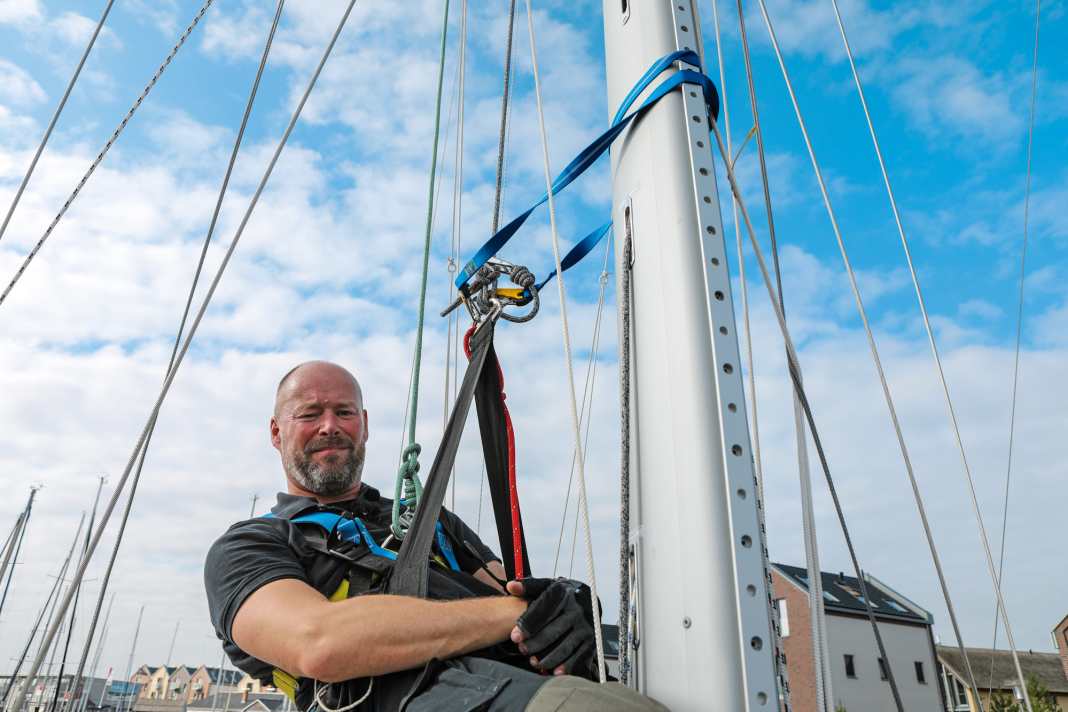


The person should therefore always remain as close as possible to the mast profile. A simple rope sling is sufficient for this. A safety harness with a carabiner is better. This can be quickly released and reattached to the spreaders or alternatively attached to shrouds or stays.
Alternatively, a second line tensioned downwards can stabilise the ascent. It is directed to the foot of the mast, onto the foredeck or into the cockpit and should always be kept as taut as possible to prevent the halyard from drifting sideways, for example due to the wind.
Double fuse
Safety is the top priority for this operation. The person is several metres up in the air, and a fall would inevitably result in serious injuries. It is therefore advisable not to rely solely on the bosun's chair or climbing harness, but to secure yourself with a second, completely redundant system. This applies all the more if it is a foreign yacht. It is almost impossible to estimate how good the quality of the traps, clamps and the usually available bosun's chair will be.
A second halyard increases safety enormously. This should not be attached to the bosun's chair or climbing harness in order to be completely redundant. A simple bowline under the shoulders is not recommended, as the person can slip out of this loop. The fire brigade rescue knot is better. With both variants, however, the cordage cuts severely under load, which can lead to immense pain.
Fire brigade rescue knots
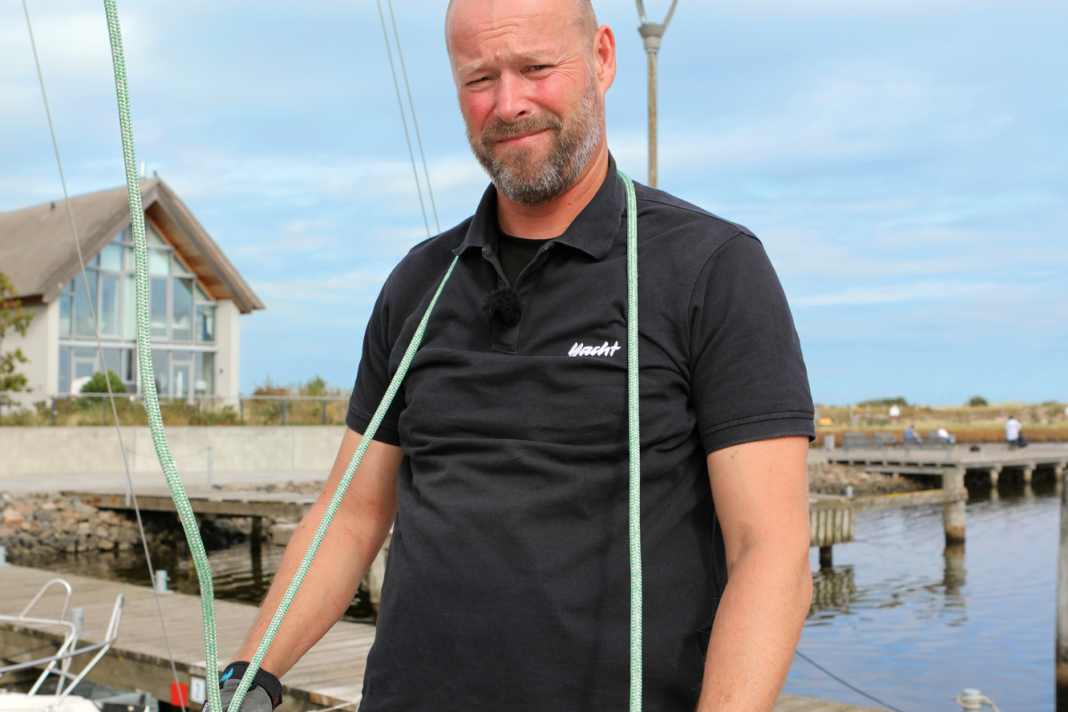





A lifebelt is better. This prevents the person being rescued from slipping out of it, and the wide straps also distribute the load better.
In addition to the actual working halyard, a second halyard - such as the spinnaker halyard or a swivel - serves as a safety device. However, it is not advisable to tie these to the bosun's chair as well. If the straps on the chair break, even the second halyard is useless. It should therefore be attached to the person themselves.
The slack from this case must be constantly pulled out by the helper during ascent, and must be constantly pulled along during descent. It is best operated by an additional helper.
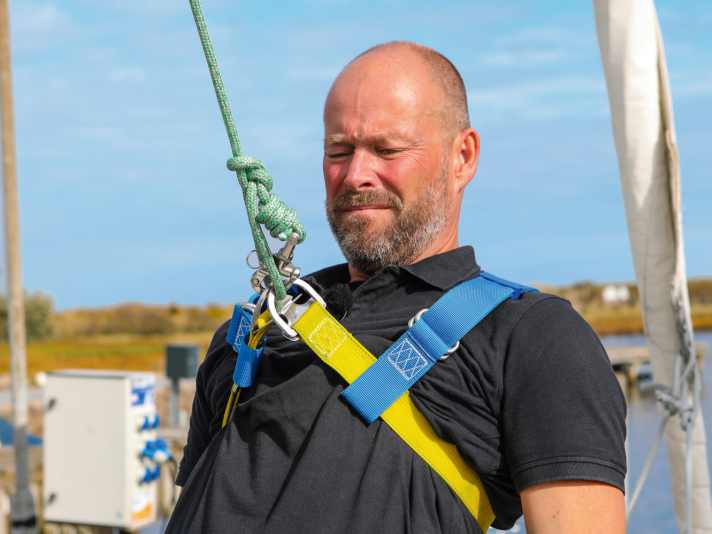
If the fractional rig is the gennaker or spinnaker halyard, this limits the ascent height. In order to get all the way to the top of the mast, the safety line has to be fished a little on the last section. If the person falls during this phase, they will fall, but only a few metres and not all the way to the deck.
The following applies when attaching lines: Never attach the halyards to the climbing equipment with a shackle or even a snap shackle! This is because these fittings can come undone under certain circumstances. Simple carabiners are also out of the question; at best, those with a screw lock are suitable as a connection. It is better to tie the lines with a bowline.
Your equipment should include gloves, preferably with free fingertips for delicate work. You should also wear sturdy shoes and long, close-fitting clothing; otherwise abrasions can occur on fittings or shrouds, especially on bare legs.
A feat of strength for the helper
The heavier and more passive the person who is being hoisted, the more work it takes to pull them up the mast. However, the effort can be minimised with the right technique.
The more the climber lifts himself, i.e. climbs along, the easier it is for the helper. Lower and intermediate shrouds are well suited for pulling. You can also use your legs to provide support at the feet of the spreaders. Always ensure that you are sitting correctly in the chair!
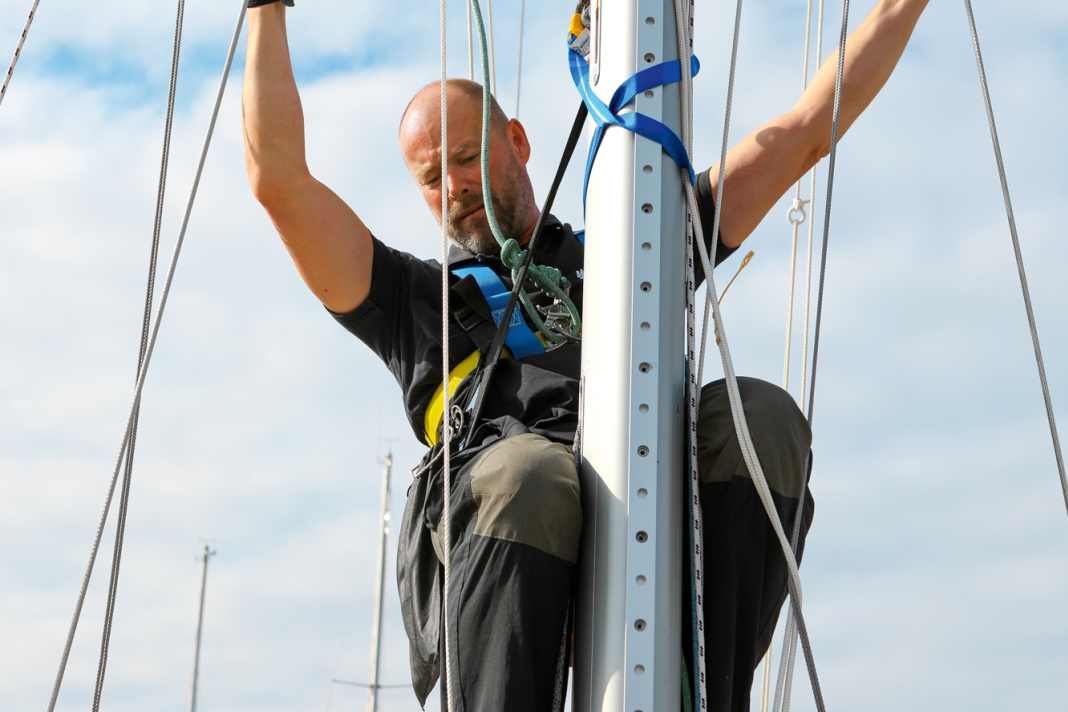




Preheating on the mast is a further aid, but two helpers must be available for this. The stronger and heavier person jerks his weight into the halyard at the mast and lifts the person up the mast. He then releases the halyard and the second helper pulls off the slack in the cockpit. Always keep the halyard clamp closed!
It is also very helpful to use the largest winches on board, i.e. the genoa winches, instead of the usually smaller halyard winches. If the cockpit geometry allows, the halyard can be redirected to one of the genoa winches; these are designed for higher loads.
If deflection in the cockpit is not possible, the halyard can be led from the mast foot to the genoa lifting point and from there to the winch, provided the angle is correct. In this case, however, the important safety device via the halyard stopper is omitted.
In general, the utmost attention must be paid to securing the case. A few tips:
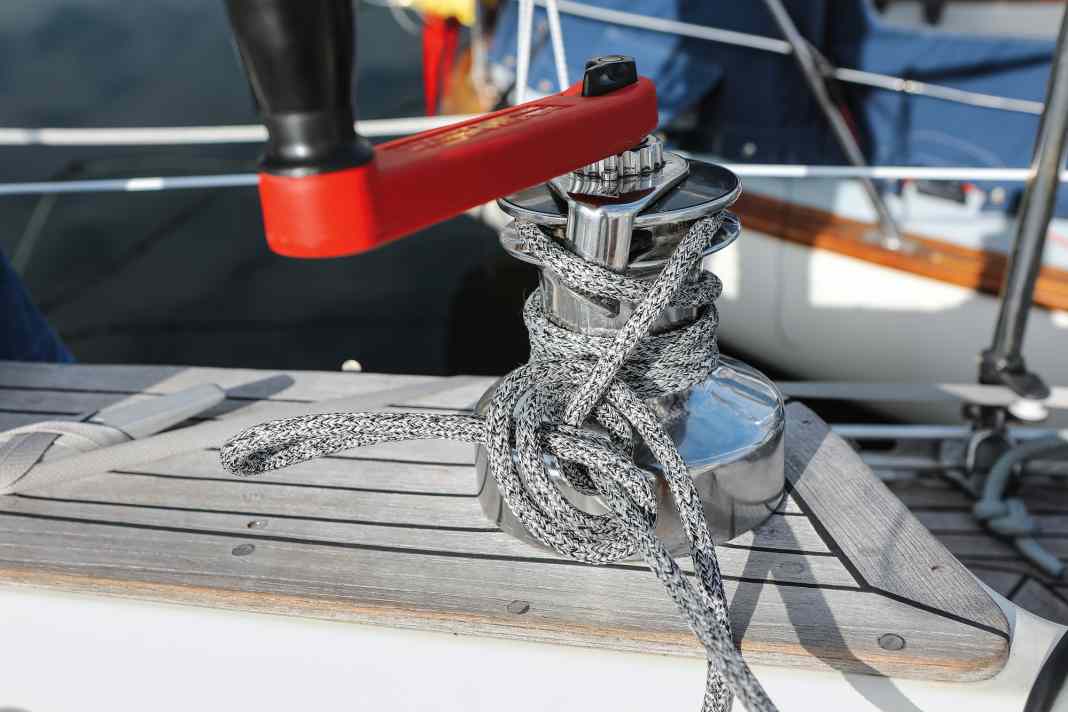



Good preparation for launching also includes thinking ahead about all the necessary work steps and having the appropriate tools and materials with you. However, it is also important that nothing can fall down, as this could injure the helpers or cause damage to the boat. If something is forgotten, it can be reordered using a bag. However, this assumes that an appropriately long line has been taken to the top.
